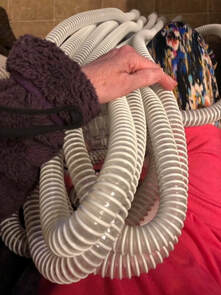 A large amount of ventilator tubing is carried on the lap of a wheelchair user A large amount of ventilator tubing is carried on the lap of a wheelchair user Dear Andrea, I am new to using ventilation assistance, and I'm wondering how I should wash the re-usable supplies and things that are not frequently replaced by my DME. Thanks, NIV Supply Newbie Dear Supply Newbie, While my supplies cleaning method is not the only way and perhaps not even the best way, it's a method I've used since I began ventilation assistance in late 2013. I'm happy to share it with you but encourage you to ask around and hear what others are doing so that you may find a method that suits you best. Our members of the Breathe with MD Support Group have a lot of supply cleaning ideas, so be sure to join that group if you have not already. Then you can search at the top of the group for a keyword like "cleaning," and find all of our past discussions on cleaning supplies. . As for my method, once a week I gather all the supplies I used that week that are washable. This includes tubing used for my ventilator's night prescription and my CoughAssist; my mask and mouthpiece parts; and my humidifier water chamber. Unless I have been sick, every two weeks, I gather up my daytime prescription's mouthpiece ventilation tubing. (I only use my mouthpiece ventilation as needed.) I fill my large farmhouse kitchen sink with two rectangular bins that hold water. I have a fragrance and dye free, gentle, liquid soap that I mix with moderately hot water in one bin. I then soak the supplies, (sometimes in two different batches, depending on the amount of tubing I have from that week), for anywhere from 20 minutes to one hour. I pay careful attention to the tubing and ensure it's not only immersed in the soapy water but filled with the soapy water. For my humidifier's water chamber, I use a small stiff bristled brush that's similar in size and shape to a toothbrush. I scrub the stainless steel bottom around the edges and up into the plastic container, getting into the bends and curves. For times when I have been sick or at least once a month, I will do a vinegar/water soak before the soapy water wash. The vinegar soak is one part white distilled vinegar and two parts water. I don't like the smell of vinegar, so I prefer to rinse those supplies and then soak them in soapy water. This ensures there is no remaining vinegar smell. Whether I'm doing the vinegar soak or not, I'm careful to rinse everything thoroughly in warm water.
When the soak and rinse process is complete, I gather the supplies and hang my tubing to dry in my utility room near the clothes dryer and a floor register that circulates air. I place the short tubes and smaller parts on a thick, folded bath towel on top of my clothes dryer. The heat from the in-use dyer seems to dry things faster in this area of my home. You might have the same fast drying results placing your supplies in a room that gets a lot of sunlight. With limited success, I have tried to dry tubing by folding it and wrapping it in bath towels gathered at the ends and center by large rubber bands. I placed those towel bundles into the clothes dryer on a low heat cycle for 30-45 minutes and tumbled to partially dry. Because I have multiples of each supply item, it's not imperative that my items dry quickly, so this drying option did not seem worth the effort to me. I usually allow 3-4 days for the wetter tubing items to thoroughly dry. I hope this gives you some ideas on how best to clean your own supplies. Wishing you the best, Andrea Comments are closed.
|
AuthorAndrea is the Founder & President of Breathe with MD, Inc. and served as Ms. Wheelchair Tennessee 2017. Her blog posts are based on experience living with a Neuromuscular Disease. The blogs are not to be used as a substitute for medical care. Always seek medical advice and care from a licensed medical professional. Archives
June 2023
Categories |
Breathe with MD, Inc. is a U.S. registered 501(c)(3) nonprofit organization. Donations are tax deductible to the extent allowable by law.
Note: This website should not be used as a substitute for medical care. For medical care or advice, please seek the care of a clinician who specializes in the breathing issues of those with Neuromuscular Disease (NMD).
Web Hosting by Hostgator
Note: This website should not be used as a substitute for medical care. For medical care or advice, please seek the care of a clinician who specializes in the breathing issues of those with Neuromuscular Disease (NMD).
Web Hosting by Hostgator

 RSS Feed
RSS Feed